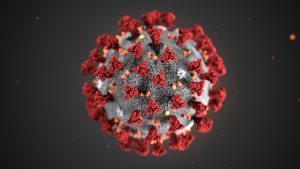What do we know about COVID-19?
The first confirmed cases of coronavirus in the United States appeared in January. At the time, the world knew almost nothing about how the virus spreads or how to treat it. Six months later, our knowledge has grown, but researchers continue to make discoveries almost daily.
A coronavirus is the name for a large set of illnesses, including the common cold and other respiratory infections. The term “novel” coronavirus means it’s a new form of the virus.

The 2019 Novel Coronavirus (2019-nCoV), portrayed in an illustration created at the Centers for Disease Control and Prevention. Alissa Eckert, MS; Dan Higgins, MAM
According to the CDC:
There is currently no vaccine to protect against COVID-19. The best way to protect yourself is to avoid being exposed to the virus that causes COVID-19.
Coronavirus (COVID-19) is an illness caused by a virus that can spread from person to person.
The virus that causes COVID-19 is a new coronavirus that has spread throughout the world.
COVID-19 symptoms can range from mild (or no symptoms) to severe illness.
You can become infected by coming into close contact (about 6 feet or two arm lengths) with a person who has COVID-19. COVID-19 is primarily spread from person to person.
You can become infected from respiratory droplets when an infected person coughs, sneezes, or talks.
You may also be able to get it by touching a surface or object that has the virus on it, and then by touching your mouth, nose, or eyes.
What is UW–Madison’s role in discovery?
UW–Madison researchers are on the front lines of COVID-19 research.Visit https://research.wisc.edu/uw-madison-research-community-responds-to-covid-19/ to learn more about research studies underway on campus.
Manuscripts and news about COVID-19 and SARS-CoV-2 virus:
- Early mutation in SARS-CoV-2 virus in Europe led to its domination worldwide
- Tracking virus mutations reveals success of stay-at-home orders
- COVID-19 model quantifies impact of region-specific social distancing orders
- UW–Madison and WNPRC scientists Dave and Shelby O’Connor are contributing to vaccine research in more ways than one!
- New Fact-Checking Projects Focus on Combatting COVID-19 Misinformation
- Multi-omic data and interactive web tool aids COVID-19 research
- UW Health Experts Share Vaccine Overview
- Large revenue shortfalls likely in central cities due to COVID-19
- Vet Med Advancing the Fight Against a Global Pandemic
-
Simpler COVID-19 test could provide results in hours from saliva
-
Can oral and nasal antiseptic prevent COVID-19?
-
The Wisconsin Economy During COVID-19: Lockdown and Reopening
- Detailed view of viral replication machinery lends new insights into infection
- New COVID-19 clinical trials at UW–Madison and UW Health will study antibody approach
- Avoiding COVID-19:Aerosol Guidelines
- Six months of coronavirus: the mysteries scientists are still racing to solve
- Coughing visualization illustrates the benefits of wearing a good mask
- Oguz Alagoz: Impact of Social Distancing on COVID-19 Burden (focus on Dane, Milwaukee, NY)
- On the fallibility of simulation models in informing pandemic responses(Lancet 30 Apr)
- Identifying airborne transmission as the dominant route for the spread of COVID-19 https://scholars.library.tamu.edu/vivo/display/n466831SE/Documents/Overvieew
- Group screening: https://www.scientificamerican.com/article/coronavirus-test-shortages-trigger-a-new-strategy-group-screening2/
“We’re learning as we go,” says Steve Ackerman, UW–Madison vice chancellor for research and graduate education.. “This is no time to take our foot off the pedal. We have learned a lot, but there’s still a lot we don’t know.”
